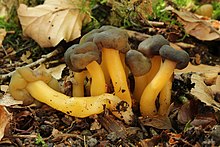| Leotia lubrica | |
|---|---|

| |
| Scientific classification | |
| Domain: | Eukaryota |
| Kingdom: | Fungi |
| Division: | Ascomycota |
| Class: | Leotiomycetes |
| Order: | Leotiales |
| Family: | Leotiaceae |
| Genus: | Leotia |
| Species: | L. lubrica
|
| Binomial name | |
| Leotia lubrica | |
| Synonyms[1] | |
| |
Leotia lubrica, commonly referred to as a jelly baby, is a species of fungus in the family Leotiaceae. L. lubrica was first validly described by Giovanni Antonio Scopoli, but it was later transferred to Leotia by Christiaan Hendrik Persoon. Its relationship with other members of the genus, of which it is the type species, is complicated.
The species produces small fruit bodies up to 6 centimetres (2+1⁄2 in) in height, featuring a "head" and a stalk. The youngest fruit bodies are small and conical, but the fertile head quickly grows from the stalk. Ochre with tints of olive-green, the heads are irregularly shaped, while the stalk, of a similar colour, attaches them to the ground. The appearance can be somewhat variable and is similar to a number of other species, including Cudonia confusa, C. circinans, L. atrovirens and L. viscosa.
L. lubrica has been recorded in Europe, Asia, North America, and Australasia. Growing in woodland among moss, plant detritus or other habitats, the fruit bodies are typically found in large numbers, though they can grow in tight clumps or even individually. The species may feed as a saprotroph or possibly obtains nutrition from living trees through ectomycorrhizae. It is often described as inedible, despite its common name, but has occasionally been reported as a good edible.
- ^ "Leotia lubrica (Scop.) Pers. 1797". Mycobank. International Mycological Association. Retrieved 27 June 2011.